History of HCI
Key systems, people and ideas
Matthias Rauterberg
Technical University Eindhoven (TU/e)
The Netherlands
�
History of Computer Technology
Digital computer grounded in ideas from
1700’s & 1800’s
Computer technology became available in
the 1940’s and 1950’s
see further: History of Computing
History of HCI
© M. Rauterberg, TU/e
2
�
Konrad Zuse (1910-1995)
In 1936 Konrad Zuse, absolutely set apart from the academic world, started
constructing an automatic machine to solve calculation problems for
designing plane wings; these analyses forcing him to long and repetitive
calculations. In his living-room and with the mere aid of few tools, he first
produced a binary mechanical memory, to which he soon connected a
mechanical calculation unit as well as a programming unit controlled from old
movie films punched by hand. He called this model V1 (Versuchsmodell 1),
but subsequently changed this name into Z1 in order not to confuse it with
the flying bombs having the same name! Having become aware of the poor
liability and slowness of this machine, in 1939, Zuse prepared a second one,
called Z2, characterized from a still mechanical memory but with a relay-
operated electromechanical calculating unit.
In the following years, Zuse accomplished a real electromechanical working computer, Z3, which was submitted in 1941 to
an audience of engineers and scientists, raising great interest. Not yet satisfied, living in a Berlin continuously bombed and in
which it was difficult to find even food, Zuse constructed Z4 with a mechanical memory (relays were now unfindable): the
machine was ended in 1944. Zuse arrived in protecting Z4 from the destructions of war and from the hands of Allies, hiding
it in a cellar in the small Bavarian village of Hindelang. Once tranquillity returned again, Zuse transferred in to the Swiss
Federal Institute of Technology (ETH), in Zurich, were it remained working for 15 years. Up to 1951, this machine remained
the only working computer in continental Europe.
The history of Zuse is emblematic for at least five reasons: 1) his contribution was completely original, as he was very
isolated from the rest of the world but even from the German research activity; 2) the fact that he has conceived a binary
representation of figures which is that adopted from all the modern computers; 3) the fact that he has independently
achieved an architecture which was already suggested by Babbage; the invention of the first programming language
(Plankalkul, 1943-45); 5) the extremely practical and simple way of facing the problem: the estimated cost of Z2 is 6.500
US $, only.
© M. Rauterberg, TU/e
3
�
Z3 (1941)
Zuse’s Z3 was the world’s first reliable working machine for very complicated
arithmetic calculations, which was freely programmable and was based on
a binary floating point number and switching system.
© M. Rauterberg, TU/e
4
Konrad Zuse in front of his reconstructed Z3
�
Eniac (1943)
– A general view of the ENIAC, the first all electronic numerical integrator
and computer in USA.
© M. Rauterberg, TU/e
From IBM Archives.
5
�
Mark I (1944)
•The Mark I paper tape readers.
© M. Rauterberg, TU/e
6
From Harvard University Cruft Photo Laboratory.
�
von Neuman Architecture (1946)
Instructions and data are stored in the same memory
for which there is a single link (the von Neumann
bottleneck) to the CPU which decodes and executes
instructions.
The CPU can have multiple functional units.
The memory access can be enhanced by use of caches
made from faster memory to allow greater bandwidth
and lower latency.
Johann (John) von Neumann
(1903-1957)
J. Presper Eckert Jr. and John Mauchly were the first to develop the von Neuman architecture. John von Neumann
wrote "First Draft of a Report to the EDVAC" describing the ideas of a stored memory computer. The complicated
story is described in the wonder history of computers "Engines of the Mind" by Joel Shurkin.
© M. Rauterberg, TU/e
7
�
Princeton Architecture (1946)
A course on computer design based on the
von Neuman concept was run by the
Moore School in 1946, and was attended
by British and American professionals.
Also in 1946, von Neuman, Herman
Goldstine and Arthur Burks published a
comprehensive report of their work at
Princeton's Institute of Advanced Study
Electronic Computer Project where they
had established themselves following
their involvement with the Moore School.
The report detailed the operation and
architecture of their work on digital
computers, and has been described as the
blue print for ‘modern' digital computing.
© M. Rauterberg, TU/e
8
�
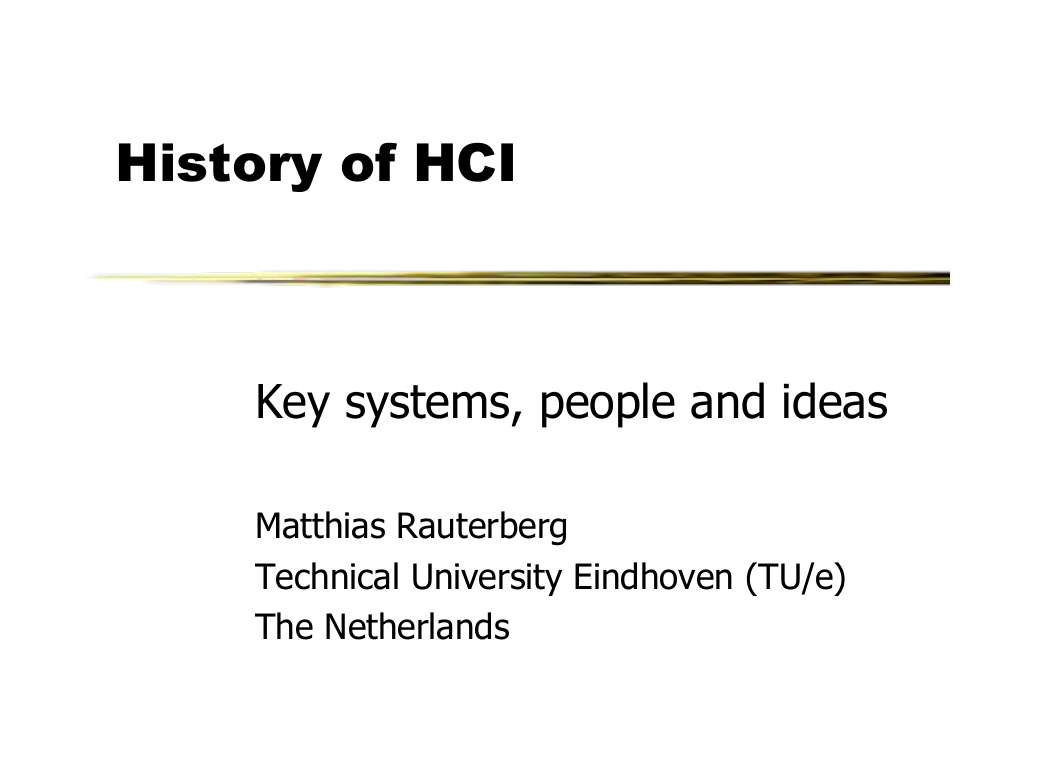

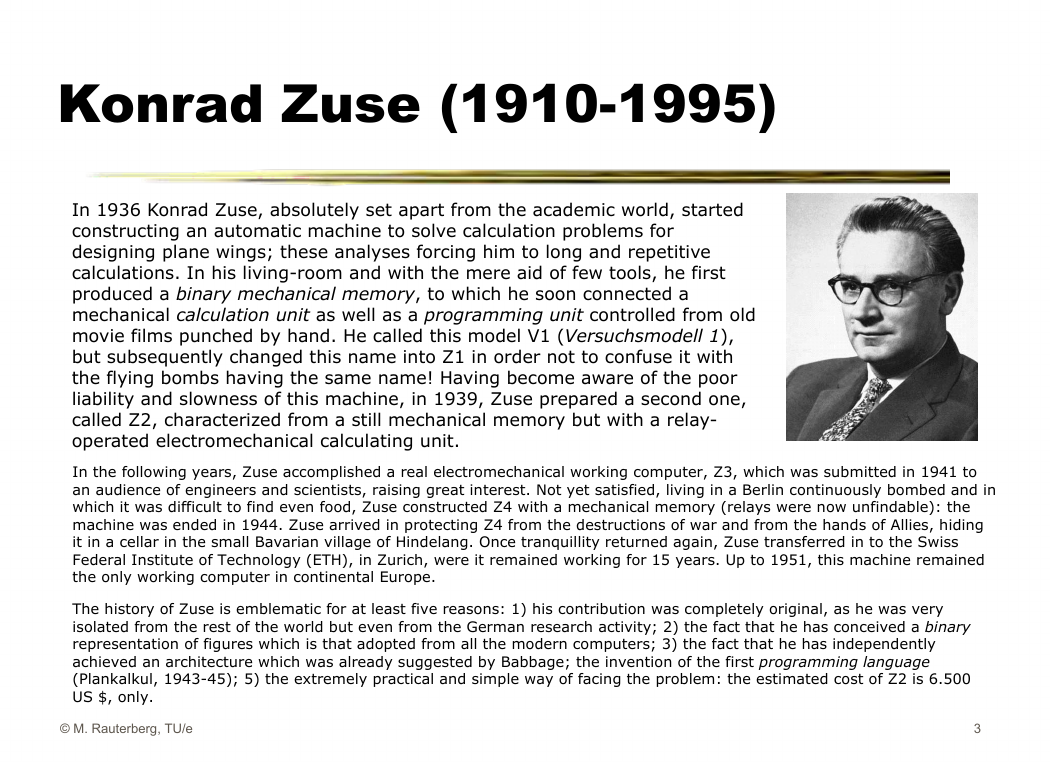
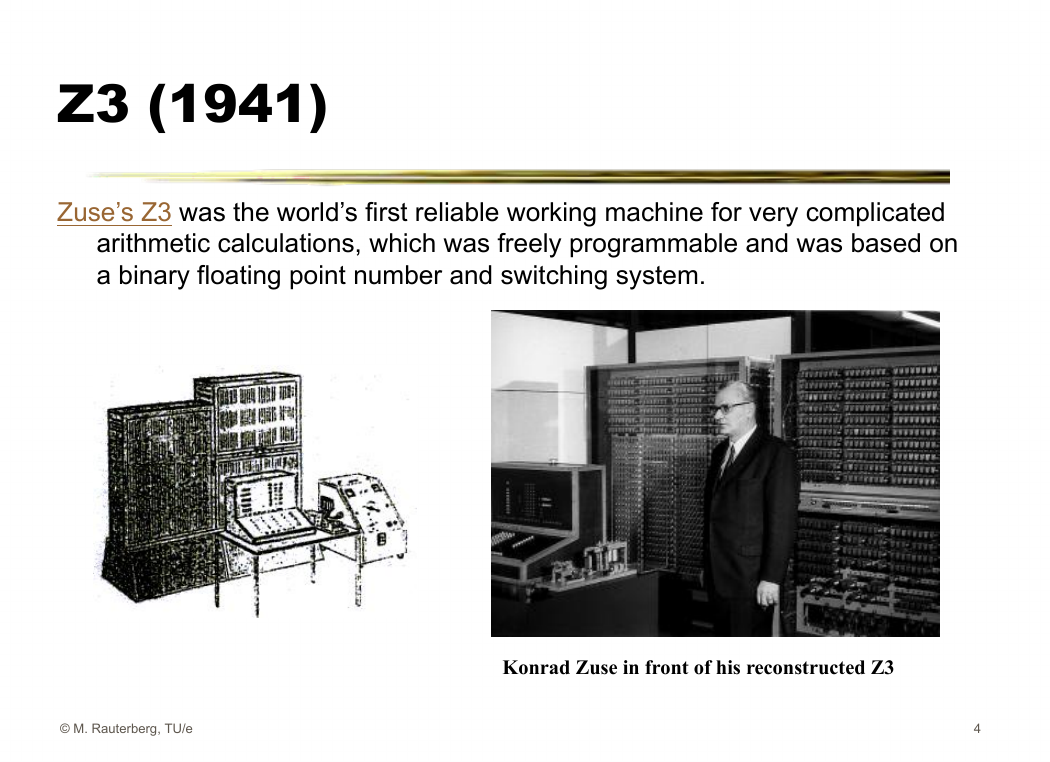

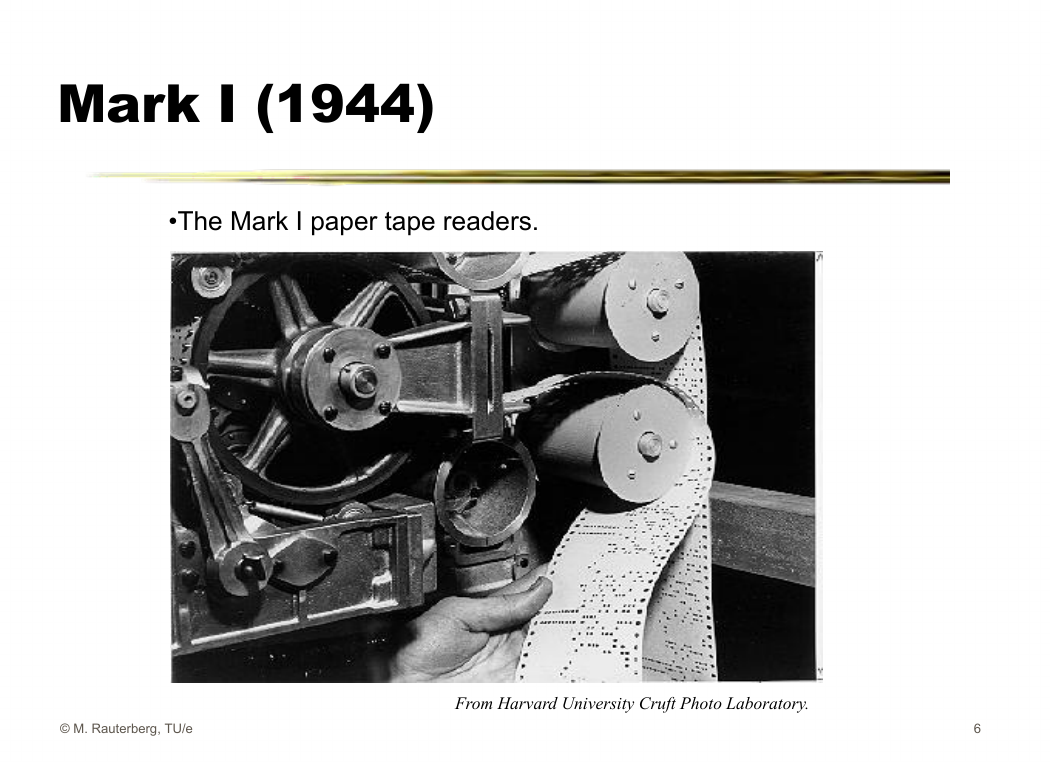
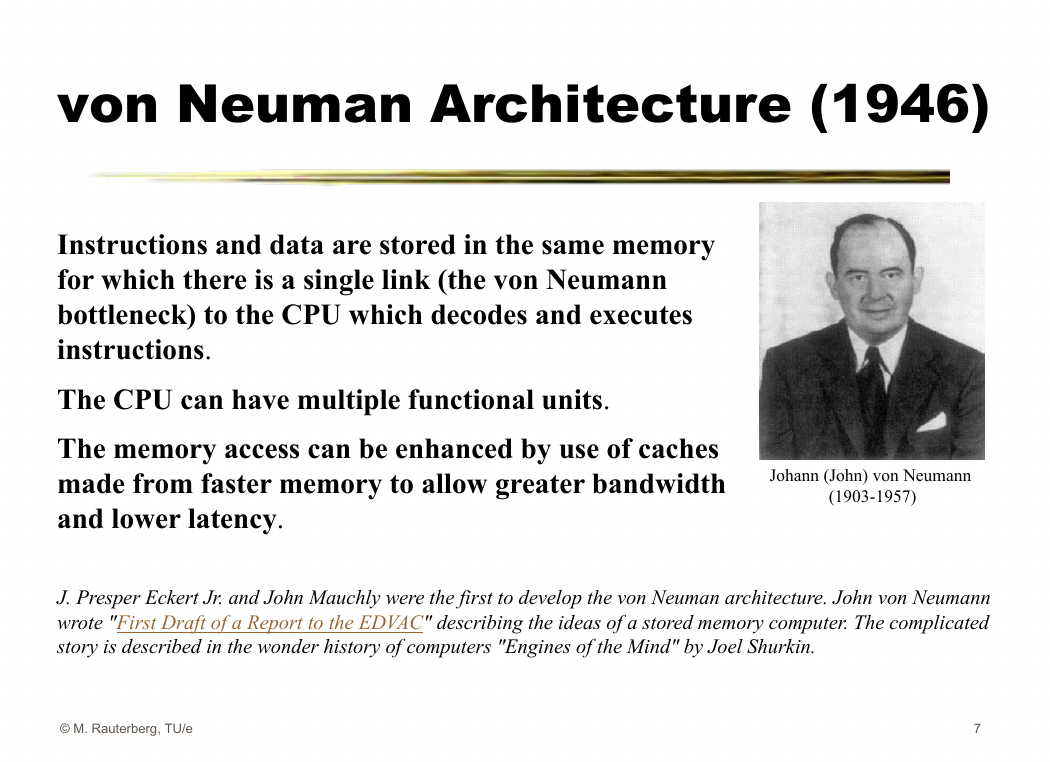
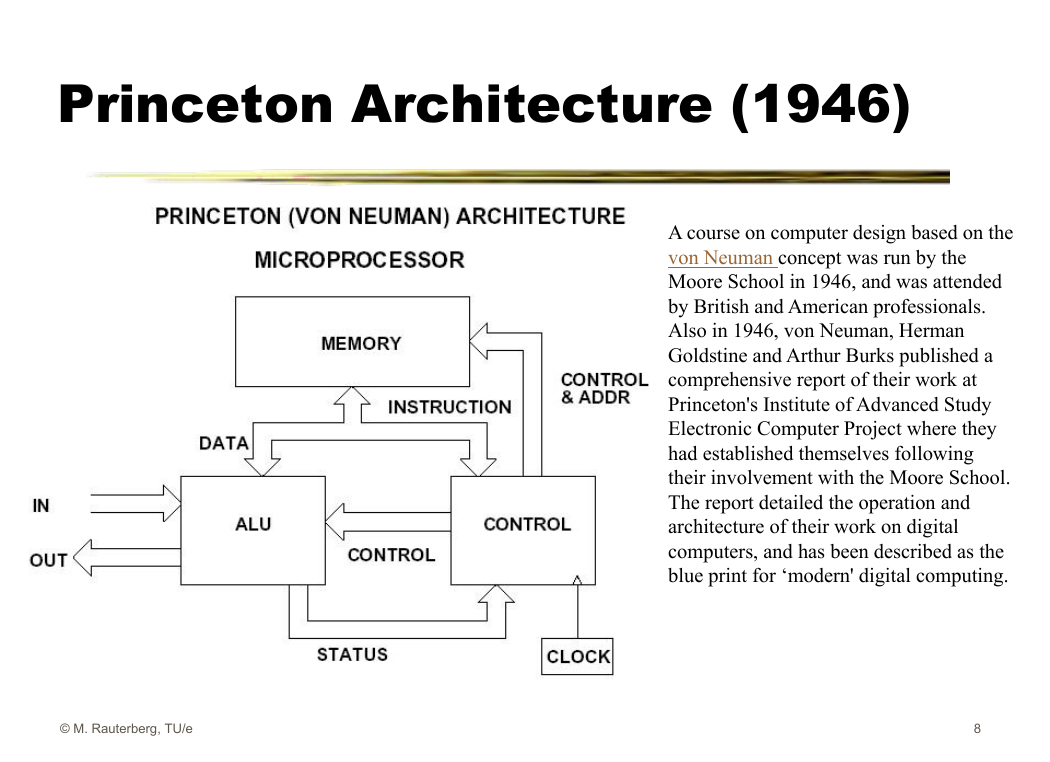








 2023年江西萍乡中考道德与法治真题及答案.doc
2023年江西萍乡中考道德与法治真题及答案.doc 2012年重庆南川中考生物真题及答案.doc
2012年重庆南川中考生物真题及答案.doc 2013年江西师范大学地理学综合及文艺理论基础考研真题.doc
2013年江西师范大学地理学综合及文艺理论基础考研真题.doc 2020年四川甘孜小升初语文真题及答案I卷.doc
2020年四川甘孜小升初语文真题及答案I卷.doc 2020年注册岩土工程师专业基础考试真题及答案.doc
2020年注册岩土工程师专业基础考试真题及答案.doc 2023-2024学年福建省厦门市九年级上学期数学月考试题及答案.doc
2023-2024学年福建省厦门市九年级上学期数学月考试题及答案.doc 2021-2022学年辽宁省沈阳市大东区九年级上学期语文期末试题及答案.doc
2021-2022学年辽宁省沈阳市大东区九年级上学期语文期末试题及答案.doc 2022-2023学年北京东城区初三第一学期物理期末试卷及答案.doc
2022-2023学年北京东城区初三第一学期物理期末试卷及答案.doc 2018上半年江西教师资格初中地理学科知识与教学能力真题及答案.doc
2018上半年江西教师资格初中地理学科知识与教学能力真题及答案.doc 2012年河北国家公务员申论考试真题及答案-省级.doc
2012年河北国家公务员申论考试真题及答案-省级.doc 2020-2021学年江苏省扬州市江都区邵樊片九年级上学期数学第一次质量检测试题及答案.doc
2020-2021学年江苏省扬州市江都区邵樊片九年级上学期数学第一次质量检测试题及答案.doc 2022下半年黑龙江教师资格证中学综合素质真题及答案.doc
2022下半年黑龙江教师资格证中学综合素质真题及答案.doc